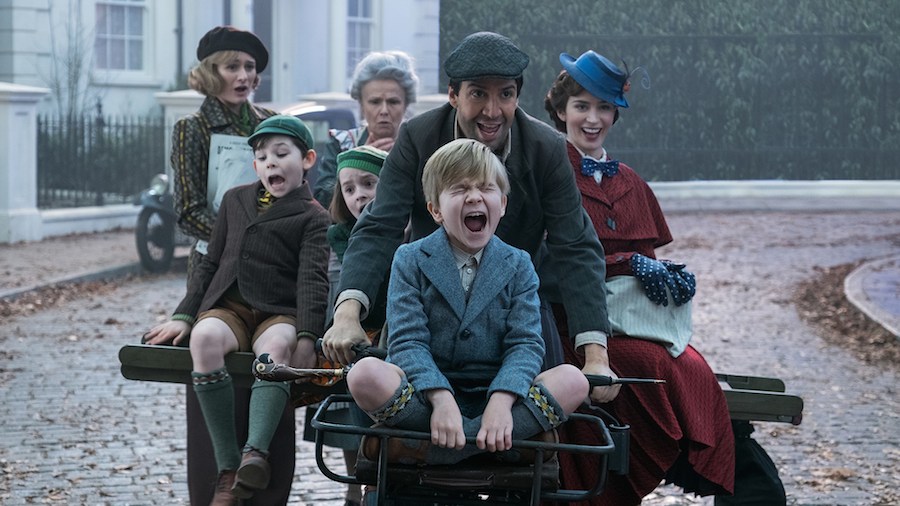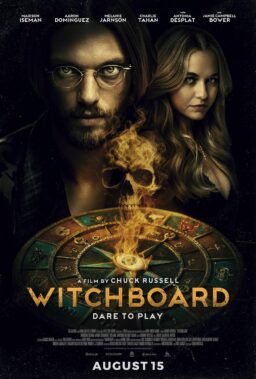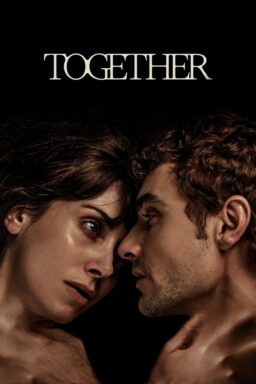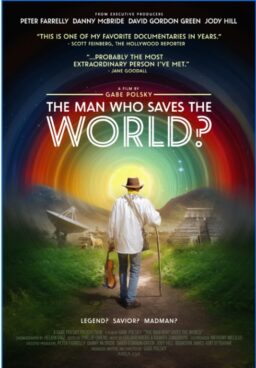“Can’t put me finger / on what lies in store / But I feel what’s to happen / all happened before.”—Bert (Dick Van Dyke) in “Mary Poppins”
Fifty-four years after its release, “Mary Poppins” remains the greatest Disney film of all time. Had “Mary Poppins Returns” been a mere remake of Robert Stevenson’s 1964 Oscar-winning classic, it would rightly be labeled a work of heresy. But what director Rob Marshall has pulled off here is more akin to James Bobin’s “The Muppets” or J.J. Abrams’ “Star Wars: The Force Awakens.” Both of these gems achieved the seemingly impossible task of recapturing the appeal of the landmark crowd-pleasers from which they spawned, and that had evaded numerous imitators. Viewers who criticized Abrams for hewing too close to the formula of “A New Hope” failed to take into account just how monumental an achievement it was to make a film that felt like “Star Wars.” Even George Lucas couldn’t replicate his own signature blend of space opera and Saturday morning serials in his enervated prequel trilogy. With “Mary Poppins Returns,” Marshall has triumphed in making a film that—with the exception of its technological flourishes—feels like it could’ve been released in the 1960s, preferably as the first half of a double bill with this year’s similarly goofy “Christopher Robin.” No attempt is made to modernize the source material of P.L. Travers’ books or the Vaudevillian charm that characterized Stevenson’s film. On an aesthetic level, it is as transporting a throwback as Todd Haynes’ “Far from Heaven,” with every cobblestone of the Banks family’s street, Cherry Tree Lane, meticulously recreated in an indoor set, courtesy of ace production designer John Myhre.
“Finding Neverland” scribe David Magee loosely mirrors the beats of the original film in his screenplay, just as composer Marc Shaiman and his “Hairspray” co-lyricist Scott Wittman have created nine new songs that pay homage, in one way or another, to the unforgettable numbers by Robert and Richard Sherman—the melodies of which are interwoven throughout the score. So immortal were the songs in “Mary Poppins” that the Sherman Brothers themselves couldn’t equal them in either “Chitty Chitty Bang Bang” or “Bedknobs and Broomsticks,” though both films went on to become widely beloved as well. How extraordinary it is to see, in 2018, a brand new old-fashioned musical, complete with an overture accompanied by paintings evocative of legendary matte artist Peter Ellenshaw. “Hamilton” creator Lin-Manuel Miranda channels the exuberance of Dick Van Dyke’s jack-of-all-trades Bert as lamplighter Jack, who opens the film with “(Underneath the) Lovely London Sky,” a stirring spin on “Chim Chim Cher-ee.” Playing the adult version of Matthew Garber’s Michael Banks, Ben Whishaw sings “A Conversation,” a poignant remembrance of his late wife, in the speak-singing style of Michael’s father (David Tomlinson), who once expounded about “The Life I Lead.”
No actor in the history of cinema has possessed the indelible screen persona, let alone the pipes, of Julie Andrews, and a “Mary Poppins” film featuring her in any role other than the titular one would feel profoundly wrong. Andrews was entirely correct in turning down a cameo role, providing Emily Blunt the space needed to create her own version of the character. She is a complete delight—sweet, sardonic and more zesty than deadpan. Her singing voice may not hit Andrews’ high notes, but it is more than capable of belting “Can You Imagine That?” (the equivalent to “A Spoonful of Sugar” that kicks off the enchantment), “The Royal Doulton Music Hall” (an abbreviated “Jolly Holiday”), “A Cover Is Not the Book” (Mary and Jack’s irreverent tongue-twisting duet that tips its hat to “Supercalifragilisticexpialidocious”) and “The Place Where Lost Things Go” (a lullaby reminiscent of both “Stay Awake” and “Feed the Birds”).
Meryl Streep delivers her best musical performance in ages as Topsy, Mary’s dotty cousin who, like Uncle Albert, has a supernatural conundrum in need of fixing, as detailed in “Turning Turtle” (a much more urgent number than “I Love to Laugh”). Jack and his fellow lamplighters’ big dance routine, “Trip a Little Light Fantastic,” is being pushed as an Oscar contender, though it’s not nearly as acrobatic or catchy as “Step in Time,” which was itself inspired by the British music hall anthem, “Knees Up Mother Brown.” My favorite song of them all is saved for last: “Nowhere to Go But Up,” a joyous companion piece to “Let’s Go Fly a Kite,” performed by living legend Angela Lansbury (who might as well be playing the grandmother of Eglantine Price, the benevolent witch she brought to life in “Bedknobs and Broomsticks”).
By the time Lansbury materialized for the grand finale, I was already levitating in my seat. Had my critical faculties been rendered useless by the glorious imagery drawn frame-by-frame, thanks to a team of veteran animators who were brought out of retirement solely for the occasion? (The fact animated flowers initially leap from a bowl, after Mary’s spinning of it causes the designs on its rim to coalesce as in a zoetrope, is a brilliant touch.) Or was it the peerless casting of Julie Walters as Ellen, the Banks clan’s longtime maid who nails the accent of Hermione Baddeley, and David Warner as Admiral Boom, a hilarious yet less surly version of Jane and Michael’s delusional neighbor? Or perhaps it was the cameo by Karen Dotrice (the original Jane Banks), who shows up just long enough to utter her trademark line, “Many thanks, sincerely.” I have no doubt my love of the picture was increased exponentially by the marvelous appearance of Dick Van Dyke as Mr. Dawes Jr., the son of the banker he played incognito in “Mary Poppins.” Inhabiting that role in the original film was Arthur Malet, who went on to play Tootles in Steven Spielberg’s “Hook,” where he received his own opportunity to defy gravity just like Mr. Dawes, Sr. The 92-year-old Van Dyke does not soar through the air on wires in “Mary Poppins Returns,” but he does leap atop a desk and dance, a euphoric sight that had the crowd at my preview screening applauding.
I’m reminded of a priceless story Van Dyke shared on the 40th anniversary DVD of “Mary Poppins.” “When I was playing the old man,” he recalled, “we would break for lunch, and on my way to the commissary, I liked to wait for the buses with the tourists to come along. Then I would start to cross the street. The bus would stop, and I would take forever to cross the road, turning toward the driver to say, ‘Thank you!’ Once the bus began moving on, I’d let it get 20 yards away before I’d pass it in a dead sprint, as fast as I could run.” That’s the same sort of childlike spirit that appears to have informed Marshall’s approach to this movie. It has the same kinetic pacing as the director’s sensational stage-to-screen adaptation, “Chicago,” and it could likely be transferred onto the stage without much alteration. What I admire most about the picture is its refusal to simply recycle what came before. It puts forth the effort to come up with new songs, set-pieces and emotional payoffs, rather than go through the motions of what had already been perfected. In an era where shot-for-shot duplicates are the new norm at Disney, “Mary Poppins Returns” stands as a definitive example of how to honor a masterpiece. “Mary Poppins” will always be irreplaceable, but this endearing tribute succeeded in making me feel like a kid again.
Header Photo Credit: Jay Maidment – © 2017 Disney Enterprises, Inc. All Rights Reserved.












